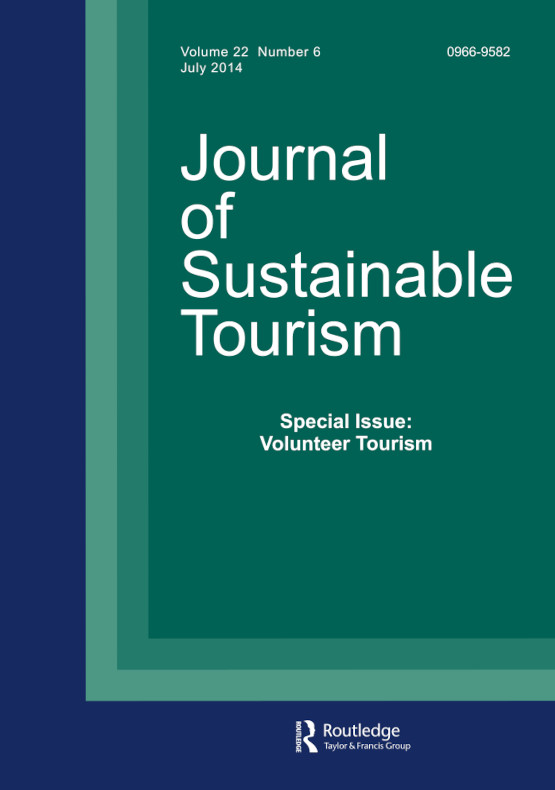Visitors’ willingness to pay for ecosystem conservation in Grenada
IF 7.8
2区 管理学
Q2 GREEN & SUSTAINABLE SCIENCE & TECHNOLOGY
引用次数: 0
Abstract
AbstractUnderstanding visitors’ willingness to pay (WTP) for natural ecosystems can assist policymakers in managing the environmental assets that form the foundation of nature-based tourism. To earn the highest economic return from limited budgetary resources, tourist-dependent destinations must identify sustainable sources of conservation funding and prioritize spending across ecosystems and initiatives. The purpose of this study is to assess the potential for visitor donations to serve as a source of conservation funding and investigate preferences and willingness to pay for multiple ecosystems concurrently, using data from a stated preference survey administered in Grenada, a small island state in the southern Caribbean that relies on nature-based tourism. Results from a discrete choice experiment and a contingent valuation exercise reveal a reluctance to donate to conservation initiatives by more than half of respondents. Visitors place the highest value on improvements to coral reefs, followed by rainforests, mangroves, and beaches. Average willingness to donate to a conservation trust fund ranged from US $8.00 to US $15.00, and from US $17.00 to US $52.00 for conservation plans targeting improvements to specific ecosystems. Few factors are found to be associated with willingness to pay. Scale heterogeneity may be a more significant source of variation than preference heterogeneity.Keywords: Willingness to paycontingent valuationdiscrete choice experimentecosystem conservationGrenadatourism Disclosure statementThe authors report there are no competing interests to declare.Notes1 Johnston et al. (Citation2017) recommend the use of a single, binary-choice WTP question for the valuation of public goods using CVM to maintain incentive compatibility.2 Survey participation was voluntary. No identifying information was collected from respondents. An introductory informed consent script informed respondents of the anonymous and confidential nature of the survey and their freedom to end the survey or refuse to answer any questions. Written consent was provided by respondents through survey completion.3 The D-efficient choice experiment design was created in SAS using the %choiceff and %mktblock macros (Kuhfeld, Citation2002).4 MXL models were specified with normal distributions and estimated using a panel specification using 500 draws from a Halton sequence. All regression analyses performed using NLOGIT 6.5 The CVM exercise was presented earlier in the survey and is shorter and less burdensome than the DCE.6 The weight command in SAS 9.4 was used to calculate weighted descriptive statistics and CVM response distributions. For logit regression analyses of CVM and DCE response data, sampling weights were applied using the ;wts specification in NLOGIT version 6, where weights were calculated using the subsample of completed responses for each valuation exercise. All calculations and analyses were also conducted using the unweighted sample, with negligeable impact on results. We present the weighted sample results to better reflect characteristics and preferences of the Grenada visitor population.7 These “other” reasons mostly pertained to tourists having already donated to other causes and feeling they had already spent enough money in Grenada.8 Exclusion of protest zero responses increases mean WTP by roughly $1.9 This “pooling back” of responses maintains the monotonicity assumption and dampens the resulting WTP estimates as responses to the pooled back bid values ($2 and $25) are treated as belonging to the next-lowest bid values ($1 and $20). See Haab and McConnel (2002, p. 69).10 Numerous model specifications were estimated, including a base model (fee value only), parsimonious models with select covariates and fee value, and more complex models, including specifications estimated using stepwise regression procedures.11 For example, respondents who are willing to return to Grenada were also generally willing to recommend Grenada to others, higher income respondents tended to be more educated, older, married, visit Grenada for shorter periods and have more Caribbean travel experience. Caribbean residents were more likely to travel to Grenada for business purposes and have more Caribbean travel experience, etc.12 Indicator variables for these countries of origin and return visitation were statistically insignificant in all model runs, hence we do not include them in our results.13 Like constant terms in linear regression models, ASCs capture the effects of non-observable variables on respondent choices. Including two ASCs for the opt-in alternatives provides more a more granular view of choices than a single ASC assigned to the opt-out alternative with no impact on other coefficients.14 All models were estimated with the full sample of DCE respondents, the subsample of respondents excluding the protest zero respondents from the CVM exercise and the subsample of respondents excluding respondents who did not select any of the conservation plans in the choice experiment (those who chose “neither plan” for all three choice panels). Analysis of these subsamples did not produce any meaningful changes in the signs or significance of the associated coefficients, and as expected, resulted in marginally higher WTP estimates.15 Models where error components were assigned to the donation plans (Plan A, Plan B) and those that mimic a nested decision structure - whereby respondents first decide whether to donate and if so, choose between Plan A and Plan B - were also estimated. Coefficient estimates were nearly identical, but these other structures produced moderately lower overall fit. Results available from the authors.16 The RPLCL specification also supports the existence of two preference groups but does not reveal significant preference heterogeneity for attributes within each class. No additional gains in fit were captured by the more complex RPLCL.游客为格林纳达生态系统保护买单的意愿
摘要了解游客对自然生态系统的支付意愿(WTP)可以帮助决策者管理构成自然旅游基础的环境资产。为了从有限的预算资源中获得最高的经济回报,依赖旅游的目的地必须确定可持续的保护资金来源,并优先考虑跨生态系统和倡议的支出。本研究的目的是评估游客捐赠作为保护资金来源的潜力,并调查同时为多个生态系统付费的偏好和意愿,使用来自格林纳达的一项声明偏好调查的数据,格林纳达是加勒比海南部一个依赖自然旅游的小岛国。一项离散选择实验和一项偶然估值练习的结果显示,超过一半的受访者不愿为保护倡议捐款。游客最看重的是珊瑚礁的改善,其次是雨林、红树林和海滩。向保护信托基金捐款的平均意愿为8.00美元至15.00美元,为改善特定生态系统的保护计划捐款的平均意愿为17.00美元至52.00美元。几乎没有发现与支付意愿相关的因素。规模异质性可能是比偏好异质性更重要的变异来源。关键词:支付意愿或有价值;离散选择实验;生态系统保护;注1 Johnston等人(Citation2017)建议使用单一的二元选择WTP问题来评估使用CVM的公共产品,以保持激励兼容性调查的参与是自愿的。没有收集受访者的身份信息。一份介绍性的知情同意脚本告知受访者调查的匿名性和保密性,以及他们结束调查或拒绝回答任何问题的自由。2 .受访者通过填写问卷提供书面同意D-efficient选择实验设计是在SAS中使用%choiceff和%mktblock宏创建的(Kuhfeld, Citation2002)MXL模型被指定为正态分布,并使用从Halton序列中抽取500个图形的面板规格进行估计。所有的回归分析都使用NLOGIT 6.5。CVM练习在调查的前面介绍,比dce更短,负担更轻。6 SAS 9.4中的权重命令用于计算加权描述性统计和CVM响应分布。对于CVM和DCE响应数据的logit回归分析,使用NLOGIT版本6中的wts规范应用抽样权重,其中使用每个评估练习的完成响应的子样本计算权重。所有的计算和分析都是使用未加权的样本进行的,对结果的影响可以忽略不计。我们提出加权样本结果,以更好地反映格林纳达游客人口的特征和偏好这些“其他”原因大多与游客已经为其他原因捐款,并认为他们已经在格林纳达花了足够的钱有关。8排除抗议零响应,平均WTP增加约1.9美元。这种响应的“汇集”维持了单调性假设,并抑制了最终的WTP估计,因为对汇集的回出价(2美元和25美元)的响应被视为属于下一个最低的出价(1美元和20美元)。见Haab and mcconnell (2002, p. 69).10估计了许多模型规格,包括基本模型(仅费用值),具有选定协变量和费用值的简约模型,以及更复杂的模型,包括使用逐步回归过程估计的规格例如,愿意返回格林纳达的受访者通常也愿意向他人推荐格林纳达,收入较高的受访者往往受教育程度较高,年龄较大,已婚,访问格林纳达的时间较短,并且有更多的加勒比旅行经验。加勒比居民更有可能出于商业目的前往格林纳达,并且有更多的加勒比旅行经验,等等。12这些原籍国和回访的指标变量在所有模型运行中统计上都不显著,因此我们没有将它们包括在我们的结果中就像线性回归模型中的常数项一样,ASCs捕获了不可观察变量对被调查者选择的影响。在不影响其他系数的情况下,为选择加入选项包含两个ASC,比为选择退出选项分配单个ASC提供了更细粒度的选择视图。 14所有模型都是用DCE受访者的完整样本进行估计的,受访者的子样本排除了CVM练习中抗议零受访者的受访者,受访者的子样本排除了在选择实验中没有选择任何保护计划的受访者(那些在所有三个选择面板中选择“两种计划”的受访者)。对这些子样本的分析在相关系数的符号或显著性方面没有产生任何有意义的变化,并且正如预期的那样,导致WTP估计值略高其中错误成分分配给捐赠计划(计划A,计划B)和那些模仿嵌套决策结构的模型-受访者首先决定是否捐赠,如果捐赠,在计划A和计划B之间选择-也进行了估计。系数估计几乎相同,但这些其他结构产生了较低的整体契合度。作者提供的结果RPLCL规范还支持两个首选项组的存在,但没有显示每个类中属性的显著首选项异质性。更复杂的RPLCL没有获得额外的拟合增益。
本文章由计算机程序翻译,如有差异,请以英文原文为准。
求助全文
约1分钟内获得全文
求助全文
来源期刊

Journal of Sustainable Tourism
Multiple-
CiteScore
23.10
自引率
8.90%
发文量
91
期刊介绍:
The Journal of Sustainable Tourism advances critical understanding of the relationships between tourism and sustainable development. The journal publishes theoretical, conceptual and empirical research that explores one or more of the economic, social, cultural, political, organisational or environmental aspects of the subject.
The Journal of Sustainable Tourism encourages critical views, as well as new ideas and approaches in relation to the theory and practice linking tourism and sustainability.
 求助内容:
求助内容: 应助结果提醒方式:
应助结果提醒方式:


